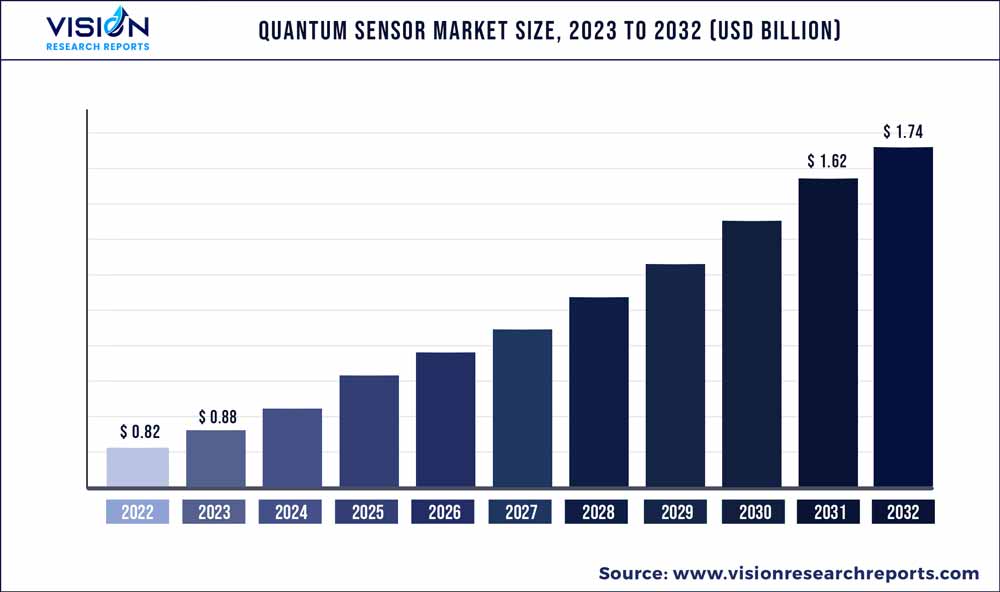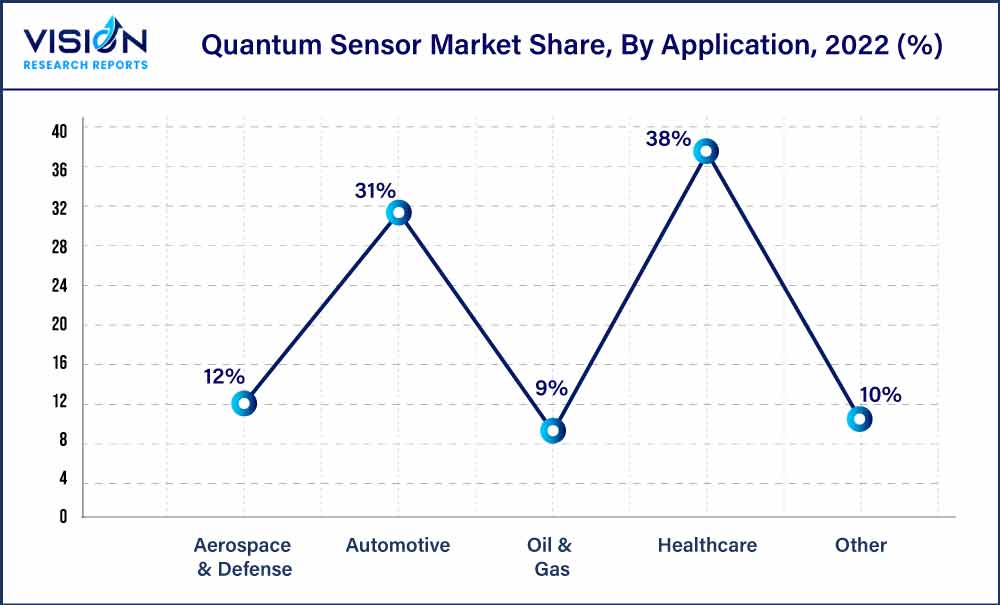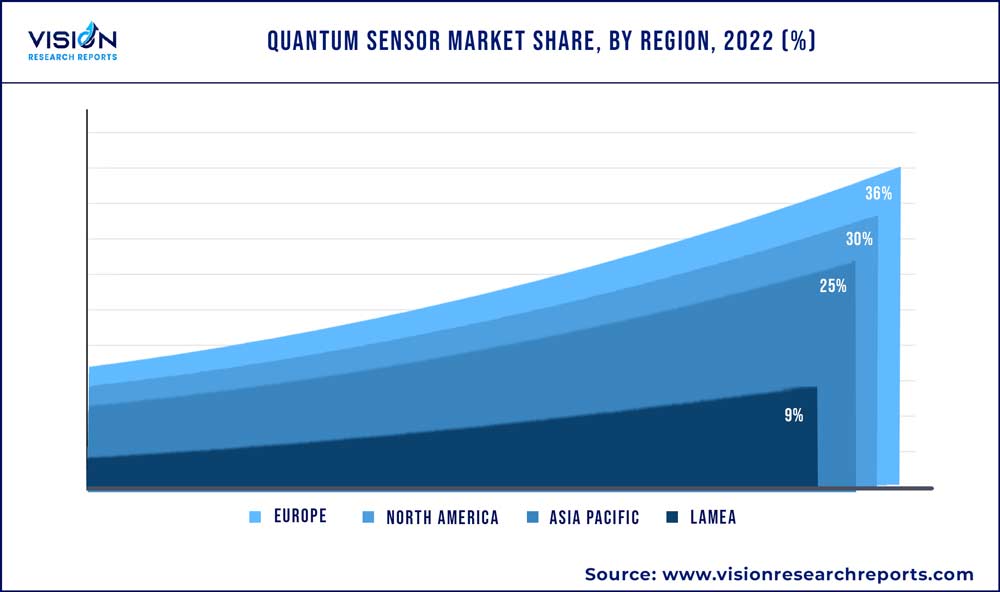The global quantum sensor market size was estimated at around USD 0.82 billion in 2022 and it is projected to hit around USD 1.74 billion by 2032, growing at a CAGR of 7.83% from 2023 to 2032. The quantum sensor market in the United States was accounted for USD 258.4 million in 2022.

Key Pointers
Report Scope of the Quantum Sensor Market
| Report Coverage | Details |
| Revenue Share of Europe in 2022 | 36% |
| Revenue Forecast by 2032 | USD 1.74 billion |
| Growth Rate from 2023 to 2032 | CAGR of 7.83% |
| Base Year | 2022 |
| Forecast Period | 2023 to 2032 |
| Market Analysis (Terms Used) | Value (US$ Million/Billion) or (Volume/Units) |
| Companies Covered | ADVA; AdSense; Biospherical Instruments Inc.; GWR Instruments Inc.; Microchip; Microsemi Corp.; Muquans SAS; Robert Bosch GmbH; Spectrum Technologies Inc.; Thomas Industrial Network Inc |
Quantum sensors are finding applications in emerging fields, such as autonomous vehicles, virtual reality, augmented reality, and the Internet of Things (IoT). For example, quantum sensors can be used for precise positioning and navigation in autonomous vehicles or to create more immersive virtual reality experiences. The expanding application areas, including defense, healthcare, aerospace, and research, open new market opportunities and drive the growth of the quantum sensor industry.
There is a growing trend towards miniaturization and integration of quantum sensors. As technology advances, researchers and manufacturers are working on developing compact and portable quantum sensors that can be easily integrated into existing systems or used as standalone devices. Miniaturization enables broader applications, increased accessibility, and cost reduction. Moreover, quantum sensors play a crucial role in quantum communication and cryptography. Quantum Key Distribution (QKD) systems rely on quantum sensors to detect and measure quantum states for secure communication.
As the demand for secure communication continues to grow, quantum sensors will be in high demand to support quantum encryption technologies. Governments and private investors are investing significantly in quantum technology research and development. These investments support market growth by fostering innovation, improving infrastructure, and promoting the commercialization of quantum technologies. For instance, in January 2023, the U.S. Department of Energy (DOE) announced $9.1 million in funding for 13 projects in Quantum Information Science (QIS) with relevance to nuclear physics.
Product Type Insights
The atomic clocks segment dominated the market in 2022 with a revenue share of 38%. Atomic clocks are highly precise devices that measure time-based on the oscillations of atoms, typically using the vibrations of atoms within a cesium or rubidium gas. These clocks have numerous applications, including satellite navigation systems, telecommunications, scientific research, and financial transactions. Atomic clocks have historically been a significant revenue generator in the market due to their crucial role in various industries. The increasing demand for precise timekeeping and synchronization in critical applications has contributed to the growth of atomic clocks.
The Photosynthetically Active Radiation (PAR) quantum sensors segment is expected to grow with the fastest CAGR during the forecast years. Controlled environment agriculture, such as vertical farming and greenhouse cultivation, is gaining traction to enhance crop production efficiency and address food security challenges. As controlled environment agriculture expands, the demand for PAR quantum sensors will likely increase. PAR quantum sensors are specialized quantum sensors used to measure the quantity and quality of light in the spectral range that plants can use for photosynthesis. These sensors are crucial in various fields, including agriculture, horticulture, and ecological research, where understanding and optimizing light conditions is essential for plant growth and productivity.
Application Insights
The healthcare segment dominated the market in 2022 with a revenue share of 38%. The ongoing technological advancements in quantum sensors are expected to drive further innovation and adoption of quantum sensors in healthcare, leading to improved diagnostics, treatment, and patient care. For instance, quantum sensors play a crucial role in MRI technology. Superconducting Quantum Interference Devices (SQUIDs), a type of quantum sensor, are used to detect and measure the weak magnetic fields generated by the body's tissues. This enables the creation of detailed and high-resolution images used for the diagnosis and monitoring of various medical conditions.

Quantum sensors, such as magnetometers based on atomic or superconducting technologies, can be employed as highly sensitive magnetic field sensors in automotive applications. These sensors can detect and measure the Earth's magnetic field or magnetic fields generated by nearby objects, enabling applications like compasses, detection of metallic objects, and collision avoidance systems. Moreover, these sensors can contribute to environmental monitoring in vehicles. For example, quantum sensors can detect and measure air pollutants, including Nitrogen Oxides (NOx) or Volatile Organic Compounds (VOCs). Integrating these sensors into vehicles can provide real-time information about air quality, allowing for more effective pollution control and improved health and safety for passengers.
Regional Insights
Europe dominated the market with a revenue share of 36% in 2022. Europe has shown significant interest and investment in quantum technology, including quantum sensors. The European Union’s Quantum Flagship program aims to position Europe as a global leader in quantum technologies. The Quantum Flagship program has allocated a significant budget of €1 billion over ten years (2018-2028). Moreover, European companies are exploring quantum sensor applications in the automotive, telecommunications, and energy sectors. The Asia Pacific region has seen considerable growth in the market. Countries like China, Japan, and South Korea have invested substantially in quantum research and development.

China has been actively promoting quantum technologies. For instance, the Chinese government launched the Quantum Science Satellite (QSS), also known as Micius, which is a Chinese satellite mission focused on quantum communication and quantum science experiments. The main objective of the QSS mission is to enable long-distance quantum communication using the phenomenon of quantum entanglement. These factors are expected to drive the regional market during the forecasted years.North America benefits from a strong presence of research institutions, universities, and technology companies focused on quantum technologies.
Government initiatives, such as the National Quantum Initiative Act based in the U.S., have supported research and development in quantum technologies. The region has witnessed collaborations between academia, industry, and government organizations to advance quantum sensor applications in various sectors, including defense, aerospace, and healthcare. For instance, in July 2021, Quantum Valley Investments (QVI), a Canadian investment firm focused on commercializing quantum technologies, collaborated with academic institutions, including the Institute for Quantum Computing at the University of Waterloo, to support research and development in quantum technologies including quantum sensors.
Quantum Sensor Market Segmentations:
By Product Type
By Application
By Regional
Chapter 1. Introduction
1.1. Research Objective
1.2. Scope of the Study
1.3. Definition
Chapter 2. Research Methodology
2.1. Research Approach
2.2. Data Sources
2.3. Assumptions & Limitations
Chapter 3. Executive Summary
3.1. Market Snapshot
Chapter 4. Market Variables and Scope
4.1. Introduction
4.2. Market Classification and Scope
4.3. Industry Value Chain Analysis
4.3.1. Raw Material Procurement Analysis
4.3.2. Sales and Distribution Channel Analysis
4.3.3. Downstream Buyer Analysis
Chapter 5. COVID 19 Impact on Quantum Sensor Market
5.1. COVID-19 Landscape: Quantum Sensor Industry Impact
5.2. COVID 19 - Impact Assessment for the Industry
5.3. COVID 19 Impact: Global Major Government Policy
5.4. Market Trends and Opportunities in the COVID-19 Landscape
Chapter 6. Market Dynamics Analysis and Trends
6.1. Market Dynamics
6.1.1. Market Drivers
6.1.2. Market Restraints
6.1.3. Market Opportunities
6.2. Porter’s Five Forces Analysis
6.2.1. Bargaining power of suppliers
6.2.2. Bargaining power of buyers
6.2.3. Threat of substitute
6.2.4. Threat of new entrants
6.2.5. Degree of competition
Chapter 7. Competitive Landscape
7.1.1. Company Market Share/Positioning Analysis
7.1.2. Key Strategies Adopted by Players
7.1.3. Vendor Landscape
7.1.3.1. List of Suppliers
7.1.3.2. List of Buyers
Chapter 8. Global Quantum Sensor Market, By Product Type
8.1. Quantum Sensor Market, by Product Type, 2023-2032
8.1.1. Atomic Clocks
8.1.1.1. Market Revenue and Forecast (2020-2032)
8.1.2. Gravitational Sensors
8.1.2.1. Market Revenue and Forecast (2020-2032)
8.1.3. PAR Quantum Sensors
8.1.3.1. Market Revenue and Forecast (2020-2032)
8.1.4. Quantum MagneticSensors
8.1.4.1. Market Revenue and Forecast (2020-2032)
8.1.5. Other
8.1.5.1. Market Revenue and Forecast (2020-2032)
Chapter 9. Global Quantum Sensor Market, By Application
9.1. Quantum Sensor Market, by Application, 2023-2032
9.1.1. Aerospace & Defense
9.1.1.1. Market Revenue and Forecast (2020-2032)
9.1.2. Automotive
9.1.2.1. Market Revenue and Forecast (2020-2032)
9.1.3. Oil & Gas
9.1.3.1. Market Revenue and Forecast (2020-2032)
9.1.4. Healthcare
9.1.4.1. Market Revenue and Forecast (2020-2032)
9.1.5. Other
9.1.5.1. Market Revenue and Forecast (2020-2032)
Chapter 10. Global Quantum Sensor Market, Regional Estimates and Trend Forecast
10.1. North America
10.1.1. Market Revenue and Forecast, by Product Type (2020-2032)
10.1.2. Market Revenue and Forecast, by Application (2020-2032)
10.1.3. U.S.
10.1.3.1. Market Revenue and Forecast, by Product Type (2020-2032)
10.1.3.2. Market Revenue and Forecast, by Application (2020-2032)
10.1.4. Rest of North America
10.1.4.1. Market Revenue and Forecast, by Product Type (2020-2032)
10.1.4.2. Market Revenue and Forecast, by Application (2020-2032)
10.2. Europe
10.2.1. Market Revenue and Forecast, by Product Type (2020-2032)
10.2.2. Market Revenue and Forecast, by Application (2020-2032)
10.2.3. UK
10.2.3.1. Market Revenue and Forecast, by Product Type (2020-2032)
10.2.3.2. Market Revenue and Forecast, by Application (2020-2032)
10.2.4. Germany
10.2.4.1. Market Revenue and Forecast, by Product Type (2020-2032)
10.2.4.2. Market Revenue and Forecast, by Application (2020-2032)
10.2.5. France
10.2.5.1. Market Revenue and Forecast, by Product Type (2020-2032)
10.2.5.2. Market Revenue and Forecast, by Application (2020-2032)
10.2.6. Rest of Europe
10.2.6.1. Market Revenue and Forecast, by Product Type (2020-2032)
10.2.6.2. Market Revenue and Forecast, by Application (2020-2032)
10.3. APAC
10.3.1. Market Revenue and Forecast, by Product Type (2020-2032)
10.3.2. Market Revenue and Forecast, by Application (2020-2032)
10.3.3. India
10.3.3.1. Market Revenue and Forecast, by Product Type (2020-2032)
10.3.3.2. Market Revenue and Forecast, by Application (2020-2032)
10.3.4. China
10.3.4.1. Market Revenue and Forecast, by Product Type (2020-2032)
10.3.4.2. Market Revenue and Forecast, by Application (2020-2032)
10.3.5. Japan
10.3.5.1. Market Revenue and Forecast, by Product Type (2020-2032)
10.3.5.2. Market Revenue and Forecast, by Application (2020-2032)
10.3.6. Rest of APAC
10.3.6.1. Market Revenue and Forecast, by Product Type (2020-2032)
10.3.6.2. Market Revenue and Forecast, by Application (2020-2032)
10.4. MEA
10.4.1. Market Revenue and Forecast, by Product Type (2020-2032)
10.4.2. Market Revenue and Forecast, by Application (2020-2032)
10.4.3. GCC
10.4.3.1. Market Revenue and Forecast, by Product Type (2020-2032)
10.4.3.2. Market Revenue and Forecast, by Application (2020-2032)
10.4.4. North Africa
10.4.4.1. Market Revenue and Forecast, by Product Type (2020-2032)
10.4.4.2. Market Revenue and Forecast, by Application (2020-2032)
10.4.5. South Africa
10.4.5.1. Market Revenue and Forecast, by Product Type (2020-2032)
10.4.5.2. Market Revenue and Forecast, by Application (2020-2032)
10.4.6. Rest of MEA
10.4.6.1. Market Revenue and Forecast, by Product Type (2020-2032)
10.4.6.2. Market Revenue and Forecast, by Application (2020-2032)
10.5. Latin America
10.5.1. Market Revenue and Forecast, by Product Type (2020-2032)
10.5.2. Market Revenue and Forecast, by Application (2020-2032)
10.5.3. Brazil
10.5.3.1. Market Revenue and Forecast, by Product Type (2020-2032)
10.5.3.2. Market Revenue and Forecast, by Application (2020-2032)
10.5.4. Rest of LATAM
10.5.4.1. Market Revenue and Forecast, by Product Type (2020-2032)
10.5.4.2. Market Revenue and Forecast, by Application (2020-2032)
Chapter 11. Company Profiles
11.1. ADVA
11.1.1. Company Overview
11.1.2. Product Offerings
11.1.3. Financial Performance
11.1.4. Recent Initiatives
11.2. AdSense
11.2.1. Company Overview
11.2.2. Product Offerings
11.2.3. Financial Performance
11.2.4. Recent Initiatives
11.3. Biospherical Instruments Inc.
11.3.1. Company Overview
11.3.2. Product Offerings
11.3.3. Financial Performance
11.3.4. Recent Initiatives
11.4. GWR Instruments Inc.
11.4.1. Company Overview
11.4.2. Product Offerings
11.4.3. Financial Performance
11.4.4. LTE Scientific
11.5. Microchip
11.5.1. Company Overview
11.5.2. Product Offerings
11.5.3. Financial Performance
11.5.4. Recent Initiatives
11.6. Microsemi Corp.
11.6.1. Company Overview
11.6.2. Product Offerings
11.6.3. Financial Performance
11.6.4. Recent Initiatives
11.7. Muquans SAS
11.7.1. Company Overview
11.7.2. Product Offerings
11.7.3. Financial Performance
11.7.4. Recent Initiatives
11.8. Robert Bosch GmbH
11.8.1. Company Overview
11.8.2. Product Offerings
11.8.3. Financial Performance
11.8.4. Recent Initiatives
11.9. Spectrum Technologies Inc.
11.9.1. Company Overview
11.9.2. Product Offerings
11.9.3. Financial Performance
11.9.4. Recent Initiatives
11.10. Thomas Industrial Network Inc.
11.10.1. Company Overview
11.10.2. Product Offerings
11.10.3. Financial Performance
11.10.4. Recent Initiatives
Chapter 12. Research Methodology
12.1. Primary Research
12.2. Secondary Research
12.3. Assumptions
Chapter 13. Appendix
13.1. About Us
13.2. Glossary of Terms
 Cross-segment Market Size and Analysis for
Mentioned Segments
Cross-segment Market Size and Analysis for
Mentioned Segments
 Additional Company Profiles (Upto 5 With No Cost)
Additional Company Profiles (Upto 5 With No Cost)
 Additional Countries (Apart From Mentioned Countries)
Additional Countries (Apart From Mentioned Countries)
 Country/Region-specific Report
Country/Region-specific Report
 Go To Market Strategy
Go To Market Strategy
 Region Specific Market Dynamics
Region Specific Market Dynamics Region Level Market Share
Region Level Market Share Import Export Analysis
Import Export Analysis Production Analysis
Production Analysis Others
Others